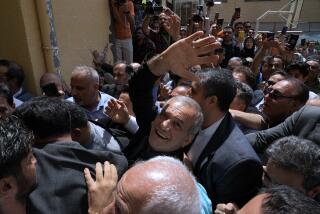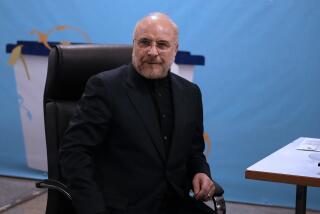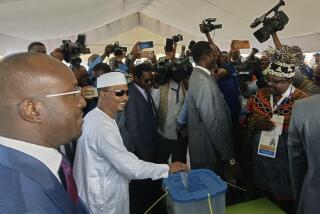Afghan Presidential Vote Set for Oct. 9, Official Says
- Share via
KABUL, Afghanistan — Afghanistan’s first direct presidential election is set for Oct. 9, a senior official said Friday, but a parliamentary vote was shelved until spring because of insufficient preparation and the threat of intimidation by warlords.
The vote will pit U.S.-backed President Hamid Karzai against half a dozen challengers.
It is regarded here as a referendum on the slow rebuilding of Afghanistan after the 2001 war. After a series of deadly attacks on election workers, the vote -- originally scheduled for June -- will also be a challenge for Afghan and international forces. They have vowed to make the election secure.
The date was announced by Zakim Shah, head of the joint Afghan-U.N. electoral commission. Shah said the parliamentary elections would probably be held in April, and he appealed to Afghan authorities and the international community to do more “to create a more secure atmosphere for the candidates and the voters.”
Karzai is expected to win a five-year term. His opponents are likely to struggle to attract votes across ethnic or geographical boundaries. If no candidate receives 50%, a runoff will be held two weeks later.
In Washington, a State Department spokesman welcomed the decision. “We’ll do our part to assist,” Richard Boucher said, adding that the United States was providing funds and expertise as well as security.
The United Nations has insisted on “meaningful” disarmament of militias before the elections to ensure that about 2,000 candidates can campaign freely and that voters are not intimidated. About 10,000 of the 60,000 militiamen to be disarmed have given up their guns.
In an effort to counter any threat, 20,000 U.S. troops and 10,000 NATO-led peacekeepers will join a similar number of Afghan soldiers and police. They are supposed to prevent the kind of attacks that have killed six election workers -- four Afghan women and two British contractors -- in shootings and bombings blamed on Taliban rebels and fighters of Afghan warlord Gulbuddin Hekmatyar.
As many as 16 Afghan men were reportedly killed in southern Afghanistan last month because they were carrying voter ID cards.
The government has yet to provide population estimates, essential to distributing the parliament’s 249 seats. There are no laws yet on media access or campaign funding.
But Afghans appear genuinely enthused by the chance to choose their leaders, and more than 6 million of the estimated 10 million eligible voters have registered. Nearly 40% of them are women.
Karzai has pledged to raise living standards and put an end to lawlessness if he wins. He has offered amnesty to former Taliban members and reached out to ethnic minorities.
Many Afghans are upset that Karzai continues to accept the support of faction leaders who helped the United States oust the Taliban but refuse to give up their power and weapons.
Factional fighting has flared in virtually every province in the north and west of the country this year. The violence is often linked to the rampant drug trade.
More to Read
Sign up for Essential California
The most important California stories and recommendations in your inbox every morning.
You may occasionally receive promotional content from the Los Angeles Times.












